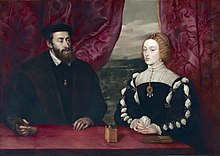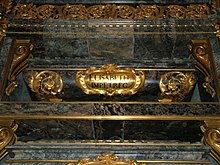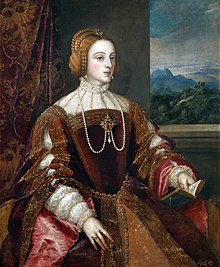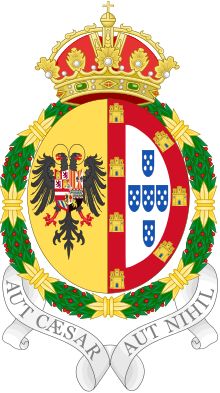Isabella of Portugal (1503–1539)
Isabella of Portugal ( Spanish Isabel de Avis ; * October 24, 1503 in Lisbon ; † May 1, 1539 in Toledo ) was the only wife of Charles V from the House of Habsburg , Emperor of the Holy Roman Empire , since 1526 .
Life
Isabella was the second child and eldest daughter of King Manuel I of Portugal from the house of Avis and his second wife, Maria of Aragon and Castile . Her maternal grandparents were the "Catholic Kings" Ferdinand II of Aragón and Isabella I of Castile , after whom she was named. Her mother raised her quite strictly and impressed her with a deep religiousness, but died in 1517 when Isabella was only 14 years old. The father then gave Isabella the property of her late mother; she was also allowed to receive income from the Portuguese cities of Viseu and Torres Vedras .

After the death of Manuel I (1521), Isabella's older brother climbed as Johann III. the Portuguese throne. Soon afterwards he began negotiations with the Spanish side regarding the marriage of Isabella, but the infanta’s marriage to Emperor Charles V was delayed, among other things, because of his enormous demands for dowry and the disputed Moluccas question between Portugal and Spain . Only the conversations resumed in May 1525 led to the breakthrough. Johann III. promised a handsome dowry of 1 million ducats. With the help of this large amount of money, Charles V was able to carry out planned political undertakings such as his trip to Italy. The future Empress was a graceful woman with an attractive appearance, had enjoyed an excellent education and, through her contact with the best Portuguese scientists and her knowledge of the reports of Portuguese sailors about distant lands, brought with her the best prerequisites for a marriage with Charles V.
On March 10, 1526, Isabella married Emperor Charles V in Seville . Because Isabella's mother Maria was also an aunt of Charles V and thus the imperial spouses were first cousins, they needed a dispensation for the marriage , which Pope Clement VII also issued. The people cheered the graceful Portuguese, who thanked her in the purest Castilian for the endless ovations and immediately won the hearts of the masses for herself.
Although the marriage of the imperial couple was purely politically motivated, the couple quickly fell in love and had an extremely happy marriage, which is also proven for posterity in the form of numerous letters between the two. Charles V always showed his wife a courtly veneration that went far beyond the usual extent. In the summer of 1526 the newlywed couple moved from Seville to Granada and stayed there in the Alhambra until the end of the year . The emperor was even reprimanded by members of the Council of State for not extending his honeymoon too long.
On May 21, 1527 Isabella gave birth to her eldest son, later King Philip II of Spain . Of their other children, their daughters Maria and Johanna also reached adulthood. Isabella brought up Philip in a rather relentless manner and severely punished him if he did not behave with enough dignity in her eyes for an emperor's son. Charles V was probably not so strict. In terms of his character, Philipp felt more like his mother than his father. He was just as cautious in public as she was and only more cordial in familiar family circles.
During the months and years of absence of the emperor, Isabella managed the affairs of state in Spain for him alone, for the first time from 1529 to 1533. Over time, she no longer acted solely on the advice of her ministers, but made increasingly independent political decisions. As the Spanish regent, she also served her husband as an important contact person for confidential messages. She maintained an intensive correspondence with him, which often revolved around political rather than personal matters. She led negotiations for marriages between members of the Spanish and French royal families and tried to avoid marriage connections between her own offspring and the much older children of Franz I. As a proponent of the Italian Renaissance , she favored the education of Spanish youth.
It weighed heavily on Isabella to spend so long periods without her husband. In addition, all of her births were extremely difficult for the delicate woman, so that one feared for her life every time. After the fourth birth, she recovered only slowly, but still took care of political issues in Spain on behalf of her husband.
death
At the age of 36, Isabella died on May 1, 1539, ten days after giving birth to her fifth child, who lived only a few hours. Charles V was deeply saddened by the death of his wife. He loved her so much that he never married again. Some Spanish nobles accompanied Isabella's funeral procession from Toledo to Granada, where she was to be buried. When the coffin was opened upon arrival at its destination to identify her body, the future Duke of Gandía, Francisco de Borja , was allegedly so dismayed by the disfigurement of her once beautiful face that he said it would never again be a secular one Serve lord. This event is said to have been the reason for his later entry into the Jesuit order. Isabella was eventually buried in the Pantheon of Kings of the El Escorial Monastery.
On behalf of Charles V, the Italian painter Titian created a portrait of Isabella in 1543 based on a template, without ever having met the Empress. But Charles V was not satisfied with the execution of the portrait, so that Tizian later reworked it in Augsburg . This time it met with the benevolence of the emperor, who also took it to the monastery of Yuste , the last place of his life. There he brought Titian's painting Gloria , which shows him praying humbly at the side of his wife Isabella and his children. They are depicted surrounded by saints and angels. On September 21, 1558, at the hour of his death, Charles V was given the same crucifix that Isabella had been holding at the time of her death.
progeny
Isabella and Charles V had the following children:
- Philip II (May 21, 1527 - September 13, 1598), King of Spain
- ⚭ 1543 Maria of Portugal (October 15, 1527 - July 12, 1545)
- ⚭ 1554 Maria I "the Bloody" (* February 18, 1516; † November 17, 1558) Queen of England
- ⚭ 1560 Elisabeth of Valois (April 2, 1545 - October 3, 1568)
- ⚭ 1570 Anna of Austria (* November 2, 1549 - † October 26, 1580)
- Maria (June 21, 1528 - February 26, 1603), ⚭ 1548 Maximilian II (July 31, 1527 - October 12, 1576), Holy Roman Emperor
- Ferdinand (* / † 1530)
- Joan of Spain (June 24, 1535 - September 7, 1573) ⚭ 1552 Johann Manuel of Portugal (June 3, 1537 - January 2, 1554)
- Johann (* / † April 20, 1539)
ancestors

| Eduard (Portugal) (1391–1438) | |||||||||||||
| Ferdinand of Portugal-Viseu (1433–1470) | |||||||||||||
| Eleanor of Aragon (1402–1445) | |||||||||||||
| Manuel I (Portugal) (1469–1521) | |||||||||||||
| John of Portugal (1400–1442) | |||||||||||||
| Beatrix of Portugal (1430–1506) | |||||||||||||
| Isabella of Braganza (1402–1465) | |||||||||||||
| Isabella of Portugal (1503–1539) | |||||||||||||
| John II (Aragón) (1397–1479) | |||||||||||||
| Ferdinand II (Aragón) (1452-1516) | |||||||||||||
| Juana Enríquez (1425–1468) | |||||||||||||
| Mary of Aragon (1482-1517) | |||||||||||||
| John II (Castile) (1405-1454) | |||||||||||||
| Isabella I (Castile) (1451–1504) | |||||||||||||
| Isabella of Portugal (1428–1496) | |||||||||||||
literature
- Constantin von Wurzbach : Habsburg, Elisabeth (Isabella of Portugal) . In: Biographisches Lexikon des Kaiserthums Oesterreich . 6th part. Kaiserlich-Königliche Hof- und Staatsdruckerei, Vienna 1860, p. 169 ( digitized version ).
- Isabella of Portugal. In: Brigitte Hamann (Ed.): The Habsburgs. 1988, ISBN 3-492-03163-3 , p. 167 f.
- Kendall W. Brown: Isabella of Portugal (1503-1539). In: Anne Commire (Ed.): Women in World History . Volume 7, 2000, ISBN 0-7876-4066-2 , pp. 733-735.
- Sigrid-Maria Großering: Karl V. - The ruler between the ages and his European family. Amalthea, 2008, ISBN 978-3-85002-927-8 .
Web links
- Carmen Sanz Ayán: Isabel de Portugal , in: Diccionario Biográfico Español . Real Academia de la Historia
Individual evidence
- ^ Alfred Kohler : Karl V. 2nd edition. Munich 2000, ISBN 3-406-45359-7 , p. 84.
- ↑ Peter Pierson: Philipp II. London 1975, German Graz / Vienna / Cologne 1985, ISBN 3-222-11593-1 , p. 12.
- ^ Alfred Kohler: Karl V. 2000, pp. 84, 113, 363.
- ↑ Ursula Tamussino: Mary of Hungary . Graz / Vienna / Cologne 1998, ISBN 3-222-12641-0 , p. 284.
| Predecessors | Office | Successors |
|---|---|---|
| - |
Queen of Spain 1526–1539 |
Mary I (England) |
| Bianca Maria Sforza |
Roman-German Empress March 10, 1526 to May 1, 1539 |
Mary of Spain (1528-1603) |
| personal data | |
|---|---|
| SURNAME | Isabella of Portugal |
| BRIEF DESCRIPTION | Wife of Charles V. |
| DATE OF BIRTH | October 24, 1503 |
| PLACE OF BIRTH | Lisbon |
| DATE OF DEATH | May 1, 1539 |
| Place of death | Toledo |


